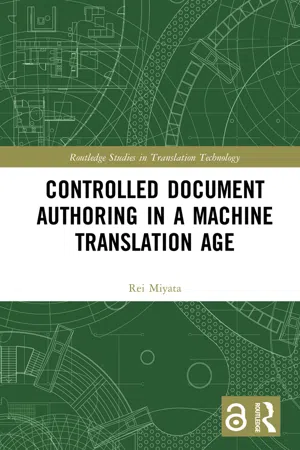
- 220 pages
- English
- ePUB (mobile friendly)
- Available on iOS & Android
Controlled Document Authoring in a Machine Translation Age
About This Book
This book explains the concept, framework, implementation, and evaluation of controlled document authoring in this age of translation technologies. Machine translation (MT) is routinely used in many situations, by companies, governments, and individuals. Despite recent advances, MT tools are still known to be imperfect, sometimes producing critical errors. To enhance the performance of MT, researchers and language practitioners have developed controlled languages that impose restrictions on the form or length of the source-language text. However, a fundamental, persisting problem is that both current MT systems and controlled languages deal only with the sentence as the unit of processing. To be effective, controlled languages must be contextualised at the document level, consequently enabling MT to generate outputs appropriate for their functional context within the target document. With a specific focus on Japanese municipal documents, this book establishes a framework for controlled document authoring by integrating various research strands including document formalisation, controlled language, and terminology management. It then presents the development and evaluation of an authoring support system, MuTUAL, that is designed to help non-professional writers create well-organised documents that are both readable and translatable. The book provides useful insights for researchers and practitioners interested in translation technology, technical writing, and natural language processing applications.
Chapter 1, the Preface, and Bibliography of this book are freely available as downloadable Open Access PDFs at http://www.taylorfrancis.com under a Creative Commons Attribution-Non Commercial-No Derivatives (CC-BY-NC-ND) 4.0 license.
Frequently asked questions
Information
Table of contents
- Cover
- Half Title
- Series Information
- Title Page
- Copyright Page
- Table of Contents
- List of Figure
- List of Tables
- Preface
- Acknowledgements
- Part I Research background
- 1 Introduction
- 2 Related work
- Part II Controlled document authoring
- 3 Document formalisation
- 4 Controlled language
- 5 CL contextualisation
- 6 Terminology management
- Part III MuTUAL: An authoring support system
- 7 System development
- 8 Evaluation of CL violation detection component
- 9 System usability evaluation
- Part IV Conclusion
- 10 Research findings and outlook
- Bibliography
- Index